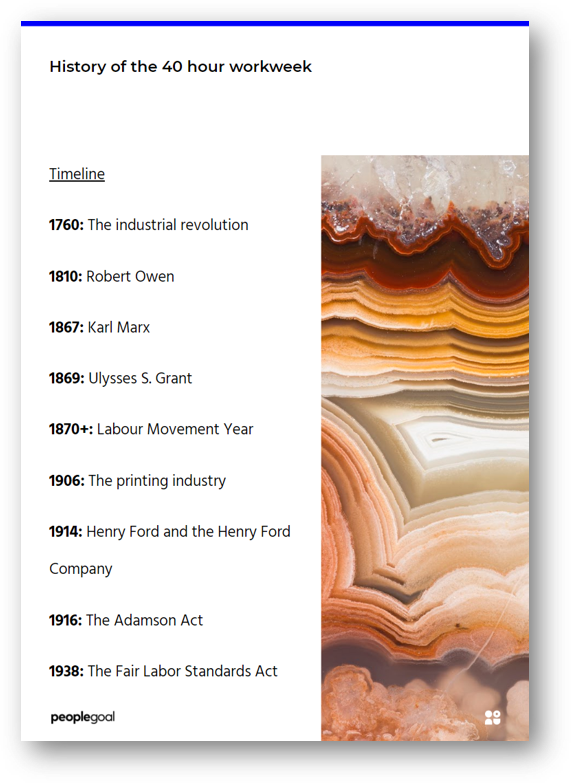The common story behind the 40-hour workweek is that it was thought-up, created and implemented by Henry Ford. But is that the true story, or is it just a misnomer? Let’s find out the true history and give it a brief rundown. Does it start with the ancient Egyptians? Unlikely, but maybe. But most likely, very unlikely. Does it originate post-second world war? Possibly, possibly. Or does the origins of the 40-hour workweek originate somewhere in between both periods? This is the most likely. It’s probably nearer the more modern end of the spectrum. Anyway. Enough chat lets go back to the start.

The Industrial Revolution (Started 1760)
The industrial revolution is a topic a lot of us learn about at school. Its importance cannot be underrated in the modern age. But how does its influence cover the inception of the 40-hour workweek? Well, essentially, it transformed working life. Instructing workers to work structured hours and complete shifts. It was the inception of the timetable at work. The clock-in/clock-out creator.
Robert Owen (1810-1817)
Robert Owen was a textile manufacturer and philanthropist. He is known for his efforts to improve working conditions and promoted experimental socialistic communities. He believed that the 10-hour working day was the way forward. Now, this sounds like a long day to you and me, but this would have felt like a holiday back then. Robert Owen later raised the demand for the 8-hour working day. In 1817 he set about raising awareness for the 8-hour working day with the slogan “8 hours labor, 8 hours recreation, 8 hours rest".
Karl Marx (1867)
Karl Marx advocated for shorter working days in his classical piece ‘Das Kapital’:
By extending the working day, therefore, capitalist production…not only produces a deterioration of human labour power by robbing it of its normal moral and physical conditions of development and activity, but also produces the premature exhaustion and death of this labour power itself. – Karl Marx
Ulysses S. Grant (1869)
In 1869, President Ulysses Grant issued a national eight-hour day proclamation. In reality, this only affected laborers and mechanics. Employers didn’t like this change, so decreased wages so that wages per week matched the previous regime. Not to be outsmarted, Grant issued a new proclamation, decreeing that federal workers could not have their wage cut. However, this did not help the vast majority of workers.
Labour Movement Years (1870’s onwards)
Across the global, labor movements popped up demanding a shift to 8-hour days. In America for example, were:
- The Federation of Organized Trades and Labor Unions
- Knights of Labor
- American Federation of Labor
- United Main Workers
- Building Trades Council
- International Typographical Union
The Printing Industry (1906)
The 8-hour working day is widely implemented in the US printing industry.
Henry Ford and the Ford Motor Company (1914)
A lot of historians credit Henry Ford and the Ford Motor Company as the creators of the 40-hour workweek. Henry Ford believed that working longer than 40 hours in a week. People have contended that Ford conducted his own research, which indicated a slight increase in productivity with the 40-hour workweek. A lot of companies in the US began to follow suit. But the majority maintained the position of 48 hours plus per week.
The Adamson Act (1916)
The Adamson Act was a federal law, the first of its kind, which instated that interstate railroad workers would work an 8-hour day, with additional pay for overtime.
The Fair Labor Standards Act (1938)
The Fair Labor Standards Act was a revised version of a 1932 draft by Senator Hugo Black. The Fair Labor Standards Act was a US federal law laying out wage and hour standards for most private and public employers. The act established the 8-hour day and the 40-hour workweek. Additionally, it established that workers be paid for overtime, which was capped at four extra hours.
The Start of the 40-Hour Workweek Around the World
Here are the laws passed in a number of countries that established the 40-Hour Workweek. Warning! There is a wide variation in years…
- Australia: Introduced in 1948.
- Belgium: Introduced in 1924.
- Chile: Introduced in 1924.
- Finland: Introduced in 1907.
- France: Introduced in 1919.
- Germany: Signed into law during the German Revolution of 1918.
- Hungary: Introduced in 1919 by decree of the Revolutionary Governing Council.
- Indonesia: 2003 Law No. 13. Workers should work for 7 hours a day for 6 days a week or 8 hours a day for 5 days a week.
- Iran: 1946 Labor Bill.
- Japan: 1947 Labor Standards Act.
- Mexico: Article 123 of the Constitution of 1917 – provided protection for women and children, the eight-hour day, and a living wage.
- New Zealand: Introduced in 1899.
- Poland: Introduced in 1918.
- Portugal: Introduced in 1919.
- Spain: Introduced in 1919.
- United Kingdom: Working Time Regulations of 1998.
- United States: The Fair Labor Standards Act of 1938.
- Uruguay Introduced in 1915.
Ready to 3x Your Teams' Performance?
Use the best performance management software to align goals, track progress, and boost employee engagement.





